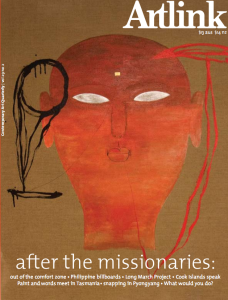After the Missionaries issue of Artlink

After the Missionaries issue of Artlink
But the world is changing. Old hierarchies are challenged now by the growth of China and India as ‘superpowers’. They are more than victims of colonisation and Western imperialism. They have their own ambitions to be seen as leaders on the world stage. Over the past two years, China, India and Japan have all held summits for the leaders of the African nations.
Climate change forces us to reconsider the relations between North and South. A major challenge of climate change is to establish a plan that has support of both rich and poor nations. The global impact of carbon emissions requires a global consensus for action. While the first world focuses on carbon reduction, the third world argues that it should not be made to suffer for sake of the rich nations. Negotiations around this are critical for the future of the planet.
Australia has been positioned as a key mediator between first and third worlds. Though a rich nation by world standards, Australia does not have the reputation of an imperial power and finds itself amongst the countries of the South, at least geographically. As potentially the ‘most Asia-literate country in the collective West’, Australia has been granted the role of mediator between USA and China.
Art has an important role to play in this.
The history of Western cultural engagement with the third world has been shadowed by primitivism. The energies and traditions of the colonised world have provided fuel to modernist and post-colonial movements in rich nations. Such dialogues have been relatively unilateral. What do the subjects of the primitivist gaze gain from this attention? How do we engage with cultures of the third world in a way that is reciprocal? While politicians go through the formalities of global summits on climate change, what role can artists and makers play in stitching together a fabric of artistic exchanges between rich Australia and poor nations?
This issue of Artlink is intended as a forum for difficult questions demanded by our time:
- On what basis can artists from the first and third worlds work together?
- On what terms can an artist or designer engage traditional artisans?
- Is visual art the exclusive domain of global elites?
- Is world craft a version of ‘noble savage’?
- Are human rights and environmentalism the thin end of the Western wedge?
Contents include:
- Haema Sivanesan – Transforming East-West dialogues: Reciprocity, collaboration, exchange
- Zoe Butt – Marching out of Step: The Long March Project in South-East Asia
- Janet de Boos – No bull in the China shop: A new path for Australian ceramics
- Neil Fettling – Hired hands: The Filipino collaborations of David Griggs
- Greg Pryor – Resuscitation through paper: Sino-Australian friendly missile test
- Ruth Hadlow – Jelek: What Australia looks like from West Timor
- Scenarios – You be the missionary: Alternative art partnerships across the global divide
- Emily Potter – A new climate for an old world: Paul Carter’s Nearamnew
- Veronica Tello – Contemporary art in the hermit kingdom: Three artists stray into North Korea
- Jacqui Durrant – Old gods, new Lives: Exhibiting traditional Cook Islander art
- Susan Cochrane – Bilum art: PNG’s ever-evolving art form
- Helen Vivian – Approaching Paradise
- Kylie Waters – Growing out of missionary roots
- Kelly Fleidner – Tudo Que Acho Nathan Gray
On sale from 15 June. To say in touch with related developments, subscribe to Craft Unbound updates (see right panel).
Related posts
One thought on “After the Missionaries”